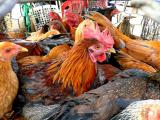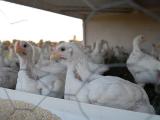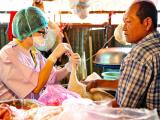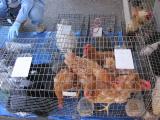Though ongoing H7N9 influenza activity in China—with eight new cases reported today—is mainly a zoonotic event, its parallel rise with seasonal flu poses a virus reassortment threat, according to a new assessment today from European health officials.
Activities surrounding Chinese New Year on Jan 31 will put humans in the crosshairs of both H7N9 and seasonal flu strains, according to the European Centre for Disease Prevention and Control (ECDC) in a comprehensive look at China's second wave of disease activity and its first update since May 2013.
Three Chinese provinces reported H7N9 cases today: four from Zhejiang, three from Guangdong, and one from Jiangsu.
Factors could intensify flu threat
The ECDC said the outbreak in China remains localized, with the virus mainly transmitted sporadically to humans who have close contact with the animal reservoir, presumably live poultry. Though the H7N9 virus doesn't appear to have the capacity for efficient human-to-human spread, new reassortants with seasonal flu strains could arm it with the ability to transmit more easily, a situation that bears close monitoring, the organization added.
Seasonal flu activity is at high levels and still increasing in China, with all three strains circulating, the World Health Organization (WHO) said yesterday in its global flu update. In southern China the dominant strains are H3N2 and the 2009 H1N1 virus, while the northern part is seeing mainly 2009 H1N1.
Brisk seasonal flu activity is occurring alongside rapidly accumulating H7N9 cases in the eastern and southern provinces. Last spring China's surveillance system picked up at least one coinfection case, that of a 15-year-old boy who recovered after he was sick with both H7N9 and H3N2.
"Hundreds of millions of Chinese are returning to their villages over the festive season in what is believed to be the world's largest annual human migration," ECDC said in its risk assessment.
Considering the spread of H5N1 avian influenza across geographic borders, it's surprising that neighboring Asian countries haven't detected more H7N9 cases, the agency said, urging countries to be on guard for imported cases.
It echoed a joint WHO-China inspection team's conclusion last spring that a cross-sector effort will be needed to reduce H7N9's threat. ECDC noted that there may be a role for a poultry H7N9 vaccine in affected parts of China, and it warned that the virus could threaten the country's food supply if it becomes highly pathogenic.
H7N9 vaccine developments
The ECDC's report reviewed the latest clinical findings, lab tools for detections, and vaccine developments. It said six clinical trials using different variants of H7N9 candidate vaccine strains have been registered with ClinicalTrials.gov and that initial results have been reported for two of them: a virus-like particle vaccine from Novavax and a cell-culture adjuvanted vaccine from Novartis.
Two phase 1 studies are enrolling participants, one supported by the US National Institute of Allergy and Infectious Diseases (NIAID) and one by GlaxoSmithKline, the ECDC said. Other studies, done with NIAID support, will test "mix-and-match" approaches that pair unadjuvanted candidate vaccines with other companies' adjuvants.
Few details are known about China's H7N9 vaccine development plans, but a report today from Xinhua, China's state news service, said one developed by Hualan Biological Engineering, Inc., has passed initial evaluation by regulators in Henan province, but it's not clear when China's Food and Drug Administration will clear it for production.
Provinces report eight new cases
In the latest outbreak developments today, the eight new cases pushed the outbreak total to 260, according to a case list compiled by FluTrackers infectious disease message board. The cases also edged the number of cases in the outbreak's second wave to 124, putting it within close shooting range of the 136 cases recorded after the virus first emerged last spring.
According to provincial health ministry statements translated and posted by the Avian Flu Diary (AFD) infectious disease blog, the patients are all adults and are hospitalized with their infections. Patients from Zhejiang province include a 43-year-old woman and a 57-year-old man with mild illnesses, an 81-year-old man in critical condition, and a 63-year old woman in critical condition.
Jiangsu province reported a 53-year-old man who is in serious condition, and Guangdong province reported three cases from Shenzhen involving a 43-year-old woman who is in stable condition and two women ages 31 and 41 who are listed as critical.
Elsewhere, health officials in Hong Kong today said no illnesses have been detected in people who had contact with infected chickens imported from Guangdong province. H7N9 test findings in the birds yesterday triggered the 3-week closure of Hong Kong's wholesale poultry market and the culling of 20,000 birds to curb the spread of the virus.
The Centre for Health Protection (CHP) said in a statement that the driver who brought the imported birds to Hong Kong is under hospital observation, is asymptomatic, and has tested negative for the virus. It added that 95 other contacts, including 49 people who helped cull the birds, are also being monitored. One market inspection officer had nonspecific symptoms but tested negative for the virus.
Hong Kong's government today said culling operations had been completed and that 22,604 birds were destroyed. They included 16,984 chickens, 2,898 silky fowls, 1,080 pheasants, and 1,642 pigeons.
See also:
Jan 27 ECDC H7N9 risk assessment update
Jan 27 WHO global flu update
Jun 14, 2013, CIDRAP News scan "H7N9-H3N2 coinfection reported in Chinese teen"
FluTrackers human H7N9 case list
Jan 28 Xinhua story
Jan 28 AFD post
Jan 28 CHP statement
Jan 28 Hong Kong government statement on poultry culling























